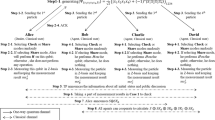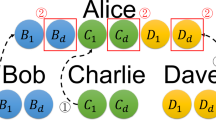Abstract
Quantum key distribution (QKD) is an effective technique to share unconditional secure keys among a pair of legal distant users with the existence of eavesdroppers. It depends upon quantum mechanics that exhibits the probability for an eavesdropper to acquire full information on the key is forbidden by the laws of physics. Though quantum mechanics assure the security of the QKD system, it is critical to inspect whether the imperfections can result in the revelation of sensitive data. The presence of imperfections can result in side-channel attacks and the ones relevant to single-photon detectors are crucial as it is adopted in several QKD approaches. For resolving these issues, this study develops a new Security in Quantum side Channel (SQSC) framework to accomplish security. The proposed SQSC approach involves the design of Shifting and Binary Conversions (SBC) algorithm with two sub-processes namely shifting process and binary conversion. Since none of the works have been developed quantum channel in the current system to secure data, the proposed model added complexity to the secret data (shifting process and binary conversion using SBC) before q-bit conversion. The design of SBC algorithm to resolve side-channel attacks and accomplish improved security shows the novelty of the work. In order to demonstrate the enhanced performance of the SQSC approach, a comparison study with existing model is performed. The experimental results reported the promising performance of the SQSC approach over the other existing methods.


Similar content being viewed by others
Data availability
The datasets created during development and analyzed during this work can be found in the Image repository, http://www.vision.caltech.edu/Image_Datasets/Caltech101/ and Quantum bit repository, https://pure.strath.ac.uk/ws/portalfiles/portal/92638035/dataset.zip.
References
Aguado A et al (2020) Quantum cryptography networks in support of path verification in service function chains. J Opt Commun Netw 12(4):B9–B19. https://doi.org/10.1364/JOCN.379799
Basso Basset F, Valeri M, Roccia E, Muredda V, Poderini D, Neuwirth J, Spagnolo N, Rota MB, Carvacho G, Sciarrino F, Trotta R (2021) Quantum key distribution with entangled photons generated on demand by a quantum dot. Sci Adv 7(12):eabe6379
Bennett CH, Brassard G (2014) Quantum cryptography. Theor Comput Sci 560(P1):7–11
Bennett CH, Bessette F, Brassard G et al (1992a) Experimental quantum cryptography. J Cryptol 5:3–28. https://doi.org/10.1007/BF00191318
Bennett CH, Brassard G, Crépeau C, Skubiszewska MH (1992b) Practical Quantum Oblivious Transfer. In: Feigenbaum J (eds) Advances in Cryptology — CRYPTO ’91. CRYPTO 1991. Lecture Notes in Computer Science, vol 576. Springer, Berlin, Heidelberg. https://doi.org/10.1007/3-540-46766-1_29.
Boaron A, Boso G, Rusca D, Vulliez C, Autebert C, Caloz M et al (2018) Secure quantum key distribution over 421 km of optical fiber. Phys Rev Lett 121:190502
Brassard G, Lütkenhaus N, Mor T, Sanders BC (2000a) Limitations on practical quantum cryptography. Phys Rev Lett 85(6):1330
Brassard G, Lutkenhaus N, Mor T, Sanders BC (2000b) "Security aspects of practical quantum cryptography." In International conference on the theory and applications of cryptographic techniques, Springer, Berlin, Heidelberg, pp 289–299
Chaiwongkhot P, Kuntz KB, Zhang Y, Huang A, Bourgoin J-P, Sajeed S, Lütkenhaus N, Jennewein T, Makarov V (2019) Eavesdropper’s ability to attack a free-space quantum-key-distribution receiver in atmospheric turbulence. Phys Rev A 99(6):062315
Clivati C, Meda A, Donadello S, Virzì S, Genovese M, Levi F, Mura A, Pittaluga M, Yuan Z, Shields AJ, Lucamarini M (2022) Coherent phase transfer for real-world twin-field quantum key distribution. Nat Commun 13(1):1–9
Grote O, Ahrens A, Benavente-Peces C (2021) Modelling and simulation of quantum key distribution using optsim. IEEE Microw Theory Tech Wirel Commun MTTW 2021:160–164. https://doi.org/10.1109/MTTW53539.2021.9607165
Jian L, Hengji L, Na W, Chaoyang L, Yanyan H, Xiubo C, Yuguang Y (2019) A quantum key distribution protocol based on the EPR pairs and its simulation. Int Conf Simul Tools Tech 295:288–301
Li J, YangYG, Chen XB, Zhou YH, Shi WM (2016) Practical quantum private database queries based on passive round-robin differential phase shift quantum key distribution. Sci Rep, 1–6.
Li S, Li L (2020) Round Shujing robin differential quadrature phase shift quantum key distribution by using odd coherent states. J Optik 227:165763
Li S, Li L (2021) Round robin differential quadrature phase shift quantum key distribution by using odd coherent states. Optik 227:165763
Lim CCW, Wang C (2021) Long-distance quantum key distribution gets real. Nat Photon 15:554–556. https://doi.org/10.1038/s41566-021-00848-1
Lopez D, Brito JP, Pastor A, Martin V, Sánchez C, Rincon D, Lopez V (2021) Madrid quantum communication Infrastructure: a testbed for assessing QKD technologies into real production networks. In: Dong P, Kani J, Xie C, Casellas R, Cole C, Li M (eds) Optical fiber communication conference (OFC) 2021, OSA technical digest (Optica Publishing Group, 2021), paper Th2A.4.
Lord A, White C, Salas EH (2021) Quantum Key distribution (QKD) and the quantum internet: the challenges facing this new technology, In: Dong P, Kani J, Xie C, Casellas R, Cole C, Li M (eds) Optical fiber communication conference (OFC) 2021 OSA technical digest (Optica Publishing Group, 2021), paper Th2A.1.
Lütkenhaus N, Jahma M (2002) Quantum key distribution with realistic states: photon-number statistics in the photon-number splitting attack. New J Phys 4(1):44
Lydersen L, Wiechers C, Wittmann C, Elser D, Skaar J, Makarov V (2010a) Thermal blinding of gated detectors in quantum cryptography. Opt Express 18(26):27938–27954
Lydersen L, Wiechers C, Wittmann C et al (2010b) Hacking commercial quantum cryptography systems by tailored bright illumination. Nat Photon 4:686–689. https://doi.org/10.1038/nphoton.2010.214
Makarov V (2009) Controlling passively quenched single photon detectors by bright light. New J Phys 11(6):065003
Mao QP, Wang L, Zhao SM (2019) Decoy-state round-robin differential-phase-shift quantum key distribution with source errors 19(56): 1–12
Park D, Kim G, Heo D, Kim S, Kim H, Hong S (2021) Single trace side-channel attack on key reconciliation in quantum key distribution system and its efficient countermeasures. ICT Express 7(1):36–40
Pinheiro PV, Pereira PC, Sajeed S, Horn RT, Bourgoin J-P, Jennewein T, Lütkenhaus N, Makarov V (2018) Eavesdropping and countermeasures for backflash side channel in quantum cryptography. Opt Express 26(16):21020–21032
Pirandola S, Andersen UL, Banchi L, Berta M, Bunandar D, Colbeck R, Englund D, Gehring T, Lupo C, Ottaviani C, Pereira JL, Razavi M, Shamsul Shaari J, Tomamichel M, Usenko VC, Vallone G, Villoresi P, Wallden P (2020) Advances in quantum cryptography. Adv Opt Photon 12:1012–1236
Pittman TB, Jacobs BC, Franson JD (2005) Heralding single photons from pulsed parametric down-conversion. Opt Commun 246(4–6):545–550
Pljonkin A, Petrov D, Sabantina L, Dakhkilgova K (2021) Nonclassical attack on a quantum key distribution system. Entropy 23(5):509
Pljonkin AP (2021) Vulnerability of the synchronization process in the quantum key distribution system. In: Research Anthology on Advancements in Quantum Technology, pp 345–354. IGI Global.
Portmann C, Renato R (2021) "Security in quantum cryptography." arXiv preprint arXiv:2102.00021 .
Qian YJ, He DY, Wang S, Chen W, Yin ZQ, Guo GC, Han ZF (2019) Robust countermeasure against detector control attack in a practical quantum key distribution system. Optica 6(9):1178–1184
Ren S, Yang S, Wonfor A, White I, Penty R (2021) Demonstration of high-speed and low-complexity continuous variable quantum key distribution system with local local oscillator. Sci Rep 11(1):1–13
Sajeed S, Chaiwongkhot P, Bourgoin J-P, Jennewein T, Lütkenhaus N, Makarov V (2015) Security loophole in free-space quantum key distribution due to spatial-mode detector-efficiency mismatch. Phys Rev A 91(6):062301
Sidhu JS, Brougham T, McArthur D, Pousa RG, Oi DK (2022) Finite key effects in satellite quantum key distribution. NPJ Quantum Inf 8(1):1–11
Siva Lakshmi P, Murali G (2017) Comparison of classical and quantum cryptography using QKD simulator. In: International Conference on Energy, Communication, Data Analytics and Soft Computing (ICECDS-2017).
Smith G (2008) “Private classical capacity with a symmetric side channel and its application to quantum cryptography. Phys Rev 78(2)
Wang S, He DY, Yin ZQ, Lu FY, Cui CH, Chen W, Zhou Z, Guo GC, Han ZF (2019) Beating the fundamental rate-distance limit in a proof-of-principle quantum key distribution system. Phys Rev X 9(2):021046
Yan YF, Zhou L, Zhong W, Sheng YB (2021) Measurement-device-independent quantum key distribution of multiple degrees of freedom of a single photon. Front Phys 16(1):1–11
Yin ZQ, Wang S, Chen W, Li HW, Guo GC, Han ZF (2014) Reference-free-independent quantum key distribution immune to detector side channel attacks , Quantum Inf Process.
Zhang Z, Guangyuan Fu, Di F, Li C, Liu J (2019) Generative reversible data hiding by image-to-image translation via GANs. Secur Commun Netw 2019:1–11
Zhang Y, Coles PJ, Winick A, Lin J, Lütkenhaus N (2021) Security proof of practical quantum key distribution with detection-efficiency mismatch. Phys Rev Res 3(1):013076
Zhou F, Qu W, Wang J et al (2020) Twin-field quantum key distribution with heralded single photon source. Eur Phys J D 74:185. https://doi.org/10.1140/epjd/e2020-10219-0
Funding
The authors declare that no funding was received for this study.
Author information
Authors and Affiliations
Contributions
Conceptualization was contributed by N. Gopinath; Methodology was contributed by N.Gopinath; Formal analysis and investigation were contributed by N.Gopinath and Dr.S.Prayla Shyry; Writing—original draft preparation was contributed by N.Gopinath; Writing—review and editing was contributed by N.Gopinath; Resources were contributed by N.Gopinath and Dr.S.Prayla Shyry; Supervision was contributed by Dr.S.Prayla Shyry.
Corresponding author
Ethics declarations
Conflict of interest
The authors have no applicable financial or non-financial interests to expose this article.
Ethical approval
Any of the authors' investigations with human participants or animals are not included in this article.
Informed consent
Any of the authors' investigations with human participants or animals are not included in this article.
Additional information
Publisher's Note
Springer Nature remains neutral with regard to jurisdictional claims in published maps and institutional affiliations.
Rights and permissions
Springer Nature or its licensor holds exclusive rights to this article under a publishing agreement with the author(s) or other rightsholder(s); author self-archiving of the accepted manuscript version of this article is solely governed by the terms of such publishing agreement and applicable law.
About this article
Cite this article
Gopinath, N., Shyry, S.P. Secured: quantum key distribution (SQKD) for solving side-channel attack to enhance security, based on shifting and binary conversion for securing data (SBSD) frameworks. Soft Comput 27, 13365–13372 (2023). https://doi.org/10.1007/s00500-022-07479-w
Accepted:
Published:
Issue Date:
DOI: https://doi.org/10.1007/s00500-022-07479-w




